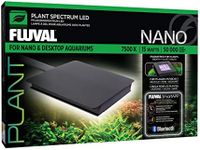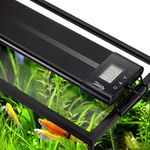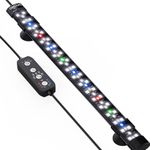Buying Guide for the Best Aquarium Lights
Choosing the right aquarium light is essential for both the health of your aquatic life and the overall look of your tank. The right lighting helps plants grow, keeps fish healthy, and makes your aquarium look vibrant and beautiful. When picking aquarium lights, it's important to consider the needs of the plants and animals you keep, as well as the size and type of your aquarium. Understanding the key specifications will help you make a choice that supports your aquarium's ecosystem and your personal preferences.Light SpectrumThe light spectrum refers to the range of colors (wavelengths) that the light emits. This is important because different aquatic plants and animals need specific types of light to thrive. For example, plants generally need more blue and red light for photosynthesis, while fish colors often look best under full-spectrum or daylight lights. Light spectrum options usually include white (daylight), blue (actinic), and sometimes red or green. If you have live plants, look for lights labeled as 'full spectrum' or 'plant-friendly.' If your tank is mostly fish, a standard daylight spectrum will usually suffice. Choose the spectrum based on whether you want to support plant growth, highlight fish colors, or both.
Light Intensity (Lumens or PAR)Light intensity measures how much light is produced and how bright it is in your tank. This is important because different plants and animals need different amounts of light. Intensity is often measured in lumens (overall brightness) or PAR (Photosynthetically Active Radiation, which is more specific to plant growth). Low-intensity lights are suitable for fish-only tanks or low-light plants, medium intensity works for most common aquarium plants, and high intensity is needed for demanding plants or deep tanks. To pick the right intensity, consider what you keep in your tank: low for just fish, medium for easy plants, and high for advanced plant setups.
Light Duration and ControlLight duration and control refer to how long the light stays on and whether you can adjust its settings. This is important because too much or too little light can harm your tank's inhabitants or encourage algae growth. Some lights come with built-in timers, dimmers, or even programmable color settings. Basic lights may just have an on/off switch, while advanced models let you set schedules and adjust brightness. If you want convenience and better control over your tank's environment, look for lights with timers or smart controls. If you prefer simplicity, a basic model will do, but you'll need to manually turn it on and off.
Size and CoverageSize and coverage refer to how well the light fits your aquarium and how evenly it lights the tank. This is important because a light that's too small won't cover the whole tank, while one that's too big may waste energy or look awkward. Lights come in different lengths and shapes to match various tank sizes. Measure your tank and choose a light that matches its length or is slightly shorter. For deep tanks, you may need a stronger light or multiple fixtures to ensure even coverage. Always match the light size to your tank for the best results.
Water Resistance and SafetyWater resistance and safety are about how well the light can handle the humid, wet environment of an aquarium. This is important to prevent electrical hazards and ensure the light lasts a long time. Some lights are fully waterproof and can be submerged, while others are only splash-resistant and should stay above the water. If your light will be close to the water or inside the tank, choose a waterproof model. For lights mounted above the tank, splash resistance is usually enough. Always check the manufacturer's safety ratings and use the light as intended.
Energy EfficiencyEnergy efficiency refers to how much electricity the light uses compared to the amount of light it produces. This is important for keeping your energy bills low and reducing heat in the tank. LED lights are the most energy-efficient and last the longest, while older types like fluorescent or incandescent use more power and need to be replaced more often. If you want to save on electricity and maintenance, choose an LED light. If you already have a fixture for another type, you can use it, but be aware of higher energy use and more frequent bulb changes.

















